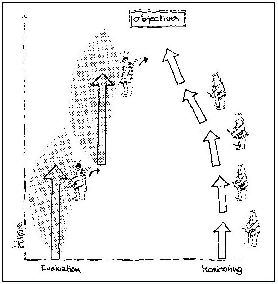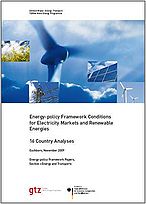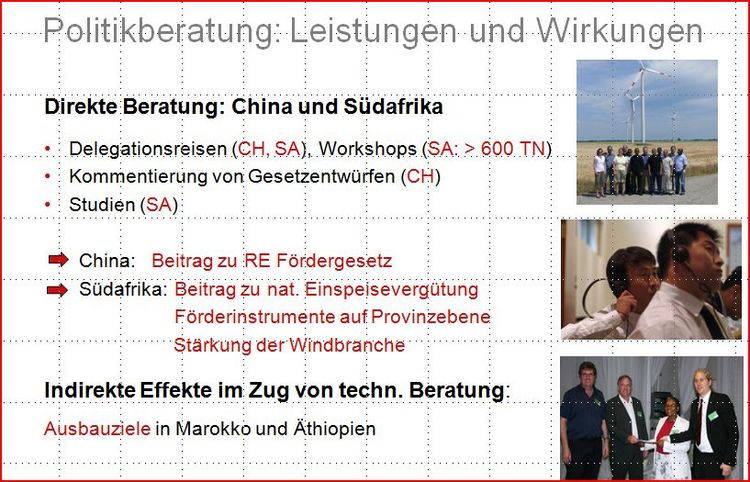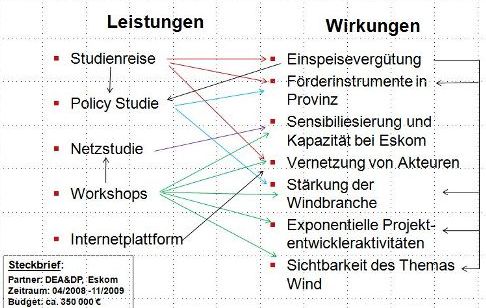Click here to register!
Difference between revisions of "Monitoring and Evaluation (M&E) - Wind Energy"
***** (***** | *****) |
***** (***** | *****) |
||
| Line 56: | Line 56: | ||
= Exemplary Results from TERNA<br><br> = | = Exemplary Results from TERNA<br><br> = | ||
| − | == Outputs - Country Studies | + | == Outputs - Country Studies == |
5 Auflagen seit 1999, 37 Länder[[Image:TERNA country study image.jpg|left|146x220px|TERNA country study image.jpg]] | 5 Auflagen seit 1999, 37 Länder[[Image:TERNA country study image.jpg|left|146x220px|TERNA country study image.jpg]] | ||
| Line 73: | Line 73: | ||
<br> | <br> | ||
| − | <br> | + | <br> |
== Outputs - Policy Advisory Services<br> == | == Outputs - Policy Advisory Services<br> == | ||
Revision as of 14:16, 10 July 2011
WORK in PROGRESS
2031_Drillisch-Suisse-Eole-6-2-04; 20091216 Präsentation TERNA Wirkungen
Introduction
‘Increasing flexibility, up to date and reliable reporting, observing achievements of objectives, potential risks, changing and unintended impacts…’[1] - development programmes/projects are committed to pursue these (and other) requirements while, simultaneously, work in an efficient, effective and sustainable manner.
Monitoring & Evaluation supports the performance of programme’s work to achieve the demanded requirements. An M&E-System can help meeting requirements of flexibility, accountability, continuous observation and information plus delivering information to the efficiency, effectiveness and sustainability of a programme.
Definition & Objectives of results-based M&E
The OECD Glossary of Key Terms in Evaluation and Results Based Management defines Monitoring as “a continuing function that uses systematic collection of data on specified indi-cators to provide management and the main stakeholders of an ongoing development inter-vention with indications of the extent of progress and achievement of objectives and progress in the use of allocated funds” [2].
- Monitoring continuously observes what is happening because of development interventions and with what effects.
- Monitoring provides information if a development intervention is still on track while following anticipated results.
- Additionally, unintended effects of the intervention resp. changing conditions in an intervention’s environment.
Monitoring can hence be labelled as a tool for the “navigation” of a project that looks at the requirements of flexibility; it observes the achievements of a project, its potential risks and the changing and unintended impacts. As such results of Monitoring can provide information to further necessary activities in order to achieve the objective(s) of a project .
Evaluation is defined by the OECD Glossary of Key Terms in Evaluation and Results Based Management as “the systematic and objective assessment of an on-going or completed pro-ject, programme or policy, its design, implementation and results (…) to determine the rele-vance and fulfillment of objectives, development efficiency, effectiveness, impact and sus-tainability.” ([3]. While Monitoring “escorts” the project continuously,
- evaluation is done at certain stages in order to assess whether the aspired objectives to these certain stages have been met.
- Evaluation does not only look at the achievement itself (what has happened?) but as well at how this has happened (or not).
- Evaluation therefore addresses accountability and, at the same time, observes inputs, activities, outputs, use of outputs and benefits with regard to planned and achieved efficiency, effectiveness and sustainability of the development intervention.
- Evaluation can therefore emphasize legitimation of a project but also may provide information that can lead to alterations of the project’s concepts.
Monitoring & Evaluation joins the functions to provide a tool that supports meeting the above mentioned requirements. Pursuing M&E will combine the information provided by both functions with the intention of knowing what has happened and with which effects. The ‘how this has happened’ will provide lessons learned for ongoing activities and future projects.
Pursuing Results-based M&E follows GTZ’s Results-based Monitoring Guidelines, indicating to take in “the whole results chain, from inputs, via activities and outputs through to the out-comes and impacts”[4] I.e. M&E will observe the mentioned result chain, probably with the following objectives:
Objectives of M&E can be:
- provision of information to what has happened because of development intervention (effects) (– Efficiency of project, accountability to clients, public)
o What has happened?
o With which effects?
o Who is doing what?...
- How has this happened and why? (programme steering)
o How did we achieve XY? (lessons learned, best practices – knowledge management)
o Why did something not happen? (lessons learned, best practices – knowledge man-agement)
o Change of conditions?
- Assessment of project’s concept and objectives – poss. providing statements to alterations (legitimation, sustainability & significance; accountability to clients, public)
o Adequate baseline information (What is the starting point? Programme steering)
o Adapted strategies according to project’s environment (programme steering)
- Assessment of project’s inputs, activities, outputs, use of outputs, benefits – poss. providing statements to alterations (Effectiveness of inputs, activities in relation to outputs, use of outputs and benefits) (accountability to clients, public – knowledge management)
Exemplary Results from TERNA
Outputs - Country Studies
5 Auflagen seit 1999, 37 Länder
- Auflage 2007: 5 000 Downloads
- Informationsvermittlung für Investoren
- Hilfe bei der Identifizierung von Zielmärkten
- Beitrag zu Investitionsentscheidungen
Outputs - Policy Advisory Services
Outputs - Windpark Planning
Indirect Results - Wind Park Planning
Higher aggregated development results in the energy sector
Armutsbekämpfung und Entwicklung
- Verbesserung der Lebensbedingungen
- Generierung von Einkommen
- Erhöhung der Versorgungssicherheit
- Verringerung der Abhängigkeit vom Öl
Klima- und Umweltverträglichkeit
- Effizienzsteigerung
- Verbreitung erneuerbarer Energien
- ↑ . BMZ/GTZ 2003: Handreichung zur Bearbeitung von AURA-Angeboten. BMZ-Referate 220 und 222, GTZ-Stabstelle 04 Unternehmensentwicklung, OE 042 Interne Evaluierung
- ↑ OECD 2002: Glossary of Key Terms in Evaluation and Results Based Management. pp. 27
- ↑ id. pp. 21
- ↑ GTZ 2008: Results-based Monitoring. Guidelines for Technical Cooperation. Eschborn
- ↑ cartoon: GTZ 1996: PIM - Booklet 4: The concept of participatory impact monitoring by Eberhard Gohl / Dorsi German. Eschborn, p. 10

























